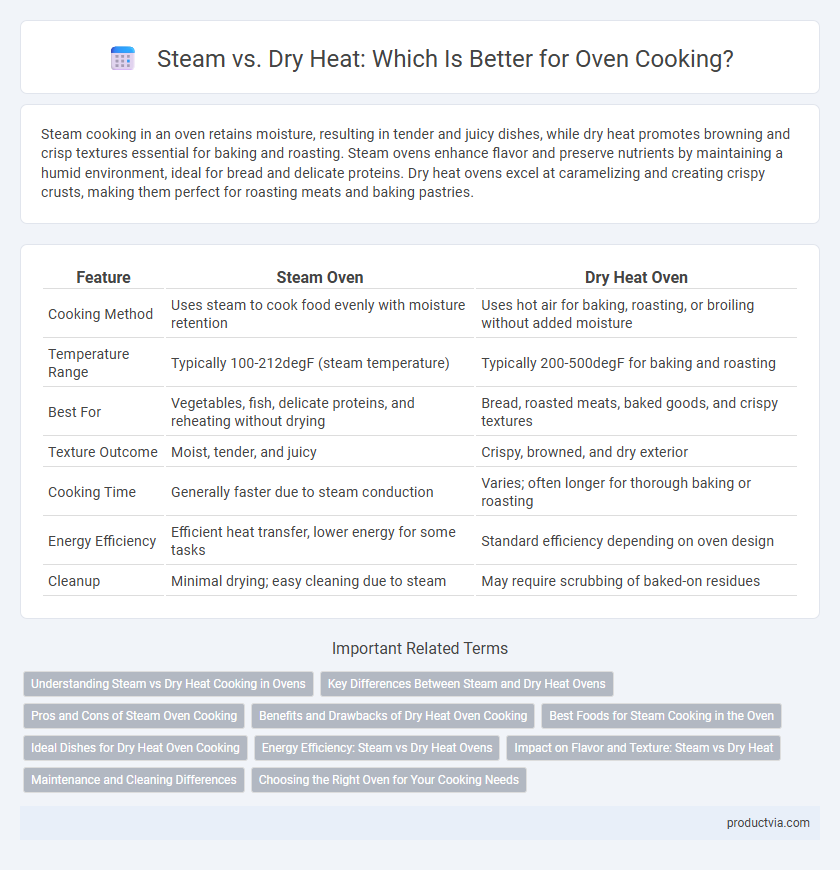Steam cooking in an oven retains moisture, resulting in tender and juicy dishes, while dry heat promotes browning and crisp textures essential for baking and roasting. Steam ovens enhance flavor and preserve nutrients by maintaining a humid environment, ideal for bread and delicate proteins. Dry heat ovens excel at caramelizing and creating crispy crusts, making them perfect for roasting meats and baking pastries.
Table of Comparison
| Feature | Steam Oven | Dry Heat Oven |
|---|---|---|
| Cooking Method | Uses steam to cook food evenly with moisture retention | Uses hot air for baking, roasting, or broiling without added moisture |
| Temperature Range | Typically 100-212degF (steam temperature) | Typically 200-500degF for baking and roasting |
| Best For | Vegetables, fish, delicate proteins, and reheating without drying | Bread, roasted meats, baked goods, and crispy textures |
| Texture Outcome | Moist, tender, and juicy | Crispy, browned, and dry exterior |
| Cooking Time | Generally faster due to steam conduction | Varies; often longer for thorough baking or roasting |
| Energy Efficiency | Efficient heat transfer, lower energy for some tasks | Standard efficiency depending on oven design |
| Cleanup | Minimal drying; easy cleaning due to steam | May require scrubbing of baked-on residues |
Understanding Steam vs Dry Heat Cooking in Ovens
Steam cooking in ovens preserves moisture and enhances food tenderness by surrounding it with moist heat, making it ideal for baking bread, roasting meats, and reheating without drying out. Dry heat cooking uses hot air circulation to achieve browning and crisp textures, suitable for roasting, baking, and broiling where caramelization and crust formation are desired. Understanding the differences helps optimize cooking techniques to achieve specific textures and flavors based on whether steam or dry heat is applied.
Key Differences Between Steam and Dry Heat Ovens
Steam ovens use moisture to cook food evenly by penetrating ingredients, preserving nutrients and enhancing texture, while dry heat ovens rely on hot air circulation to crisp and brown surfaces. Steam ovens excel in retaining food's natural juiciness, ideal for baking bread and steaming vegetables, whereas dry heat ovens offer better results for roasting meats and achieving caramelization. The key difference lies in moisture content during cooking, which affects cooking time, texture, and flavor development in each method.
Pros and Cons of Steam Oven Cooking
Steam oven cooking preserves moisture and nutrients effectively, ensuring juicier and healthier dishes compared to dry heat methods. It excels in baking bread with a crisp crust and tender crumb, but may lead to longer cooking times and less browning. However, steam ovens require regular maintenance to prevent mineral buildup and are typically more expensive than conventional ovens.
Benefits and Drawbacks of Dry Heat Oven Cooking
Dry heat oven cooking utilizes high temperatures to evenly roast, bake, or broil foods, creating crisp textures and caramelized flavors through Maillard reactions. This method is ideal for roasting meats, baking bread, and crisping vegetables but can dry out delicate dishes due to moisture loss. While it enhances browning and texture, dry heat does not retain natural juices as effectively as steam cooking, which may result in less tender outcomes for certain foods.
Best Foods for Steam Cooking in the Oven
Steam cooking in the oven excels for delicate foods like seafood, vegetables, and poultry, preserving moisture and enhancing natural flavors while retaining nutrients. Unlike dry heat, steam prevents drying and toughening, making it ideal for bread baking, where it creates a crisp crust with soft interiors. Foods high in water content, such as root vegetables and eggs, benefit significantly from steam ovens, ensuring even cooking without the risk of burning or drying out.
Ideal Dishes for Dry Heat Oven Cooking
Dry heat oven cooking excels at roasting and baking where a crispy or browned exterior is desired, making it ideal for dishes like roasted meats, vegetables, and baked goods such as bread and cookies. The consistent, high temperatures promote Maillard reactions, enhancing flavor and texture in items like prime rib, poultry, and pastries. This method is preferred for recipes requiring a firm crust or caramelization, providing golden finishes and satisfying crunch.
Energy Efficiency: Steam vs Dry Heat Ovens
Steam ovens use moisture to transfer heat more efficiently, reducing overall cooking time and energy consumption compared to dry heat ovens. Dry heat ovens rely on hot air circulation, which often requires higher temperatures and longer cooking cycles, leading to increased energy use. Studies show steam ovens can lower energy consumption by up to 25% due to faster heat transfer and reduced cooking durations.
Impact on Flavor and Texture: Steam vs Dry Heat
Steam cooking in an oven retains moisture, resulting in tender, juicy textures and enhanced natural flavors, especially in meats and baked goods. Dry heat methods, such as roasting or baking, create caramelization and Maillard reactions that develop deeper, richer flavors and crispy, browned exteriors. Balancing steam and dry heat techniques can optimize both flavor depth and texture complexity in oven-cooked dishes.
Maintenance and Cleaning Differences
Steam ovens require regular descaling to prevent mineral buildup from moisture, while dry heat ovens mainly need periodic cleaning of food residues and grease. Steam ovens often feature self-cleaning cycles that use heat and moisture to loosen grime, making maintenance easier compared to dry heat models. Dry heat ovens typically demand manual scrubbing and the use of specialized oven cleaners to maintain optimal performance and hygiene.
Choosing the Right Oven for Your Cooking Needs
Selecting an oven with adjustable steam and dry heat settings enhances cooking versatility and precision, essential for recipes requiring moisture control. Steam ovens preserve food texture and nutrients by injecting moisture during cooking, ideal for bread and delicate dishes, while dry heat ovens excel in roasting and baking with crisp finishes. Understanding the benefits of each method ensures optimal appliance choice tailored to specific culinary preferences.
Steam vs Dry Heat for Oven Cooking Infographic

 productvia.com
productvia.com